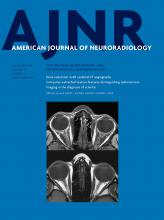We appreciate the insightful comments by Wu et al on our recent article “Computer-Assisted Detection of Cerebral Aneurysms in MR Angiography in a Routine Image-Reading Environment: Effects on Diagnosis by Radiologists.”1 We would like to address their comments and concerns.
Apparently Low Sensitivity of Both Human and Computer-Assisted Detection
First, as we described in the “Limitations” section, these “sensitivity” figures should be seen as rough estimates because the reference standard diagnoses were not determined independently by the 2 assigned radiologists. These figures largely reflect the relatively high interobserver disagreement between the 2 radiologists. Second, having a low sensitivity does not necessarily mean that we do not need screening or computer-assisted detection (CAD). Breast cancer screening by mammography, which is commonly performed with the aid of CAD, also has an unsatisfactory sensitivity, but this per se is not a limiting factor for the use of CAD. We consider that more important points are the following: 1) how often the radiologist changes his or her mind after reviewing CAD, and 2) whether that change is beneficial or detrimental. On our radiologist-oriented analysis, we found that roughly 10% more aneurysms were reported by radiologists by using CAD, which is not negligible. In addition, if we consider these additional aneurysms (ie, “missed true-positive” cases), findings for all except 1 were positive in the final diagnosis—that is, although CAD tended not to change radiologists' initial diagnoses very often, when it did, the aneurysms were obvious ones that were purely overlooked. Therefore, we believe CAD can help radiologists interpret at least in a consistent manner, reducing the inter- and intraobserver disagreement.
Management of Small Aneurysms
We agree that small aneurysms have a low rupture rate, and invasive interventions are generally no longer justified. In The University of Tokyo Hospital, all aneurysms are reported regardless of their size, but most cases with small aneurysms are simply followed up. The number of cases with large aneurysms in our study was not large enough, and we admit this small number was one of the limitations of our study.
Time to Check CAD Results
The seemingly short reviewing time (median, 16 seconds) was because the Web-based CAD server has the basic built-in paging functionality, which enables the radiologist to dismiss obvious false-positive results within a few seconds. If CAD is to be used in routine clinical practice, the effectiveness of the reviewing process is a vital requirement. When there is a suspicious lesion, the reviewing process will naturally take much longer, and there were actually many cases in which it took minutes to review the CAD results. However, because this study was conducted in a routine environment, these included some cases for which the interpretation was interrupted by a sudden phone call, for example. Therefore, we only presented the median time as the meaningful value.
Reference
- 1.↵
- © 2016 by American Journal of Neuroradiology












